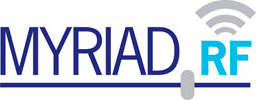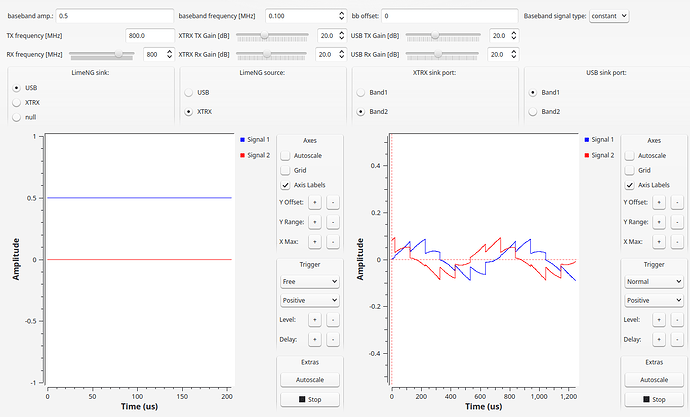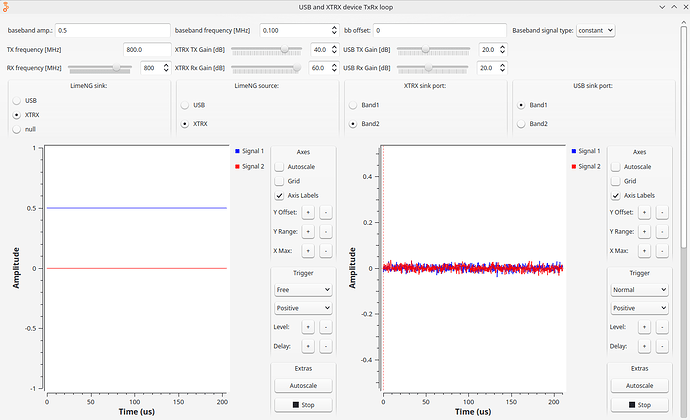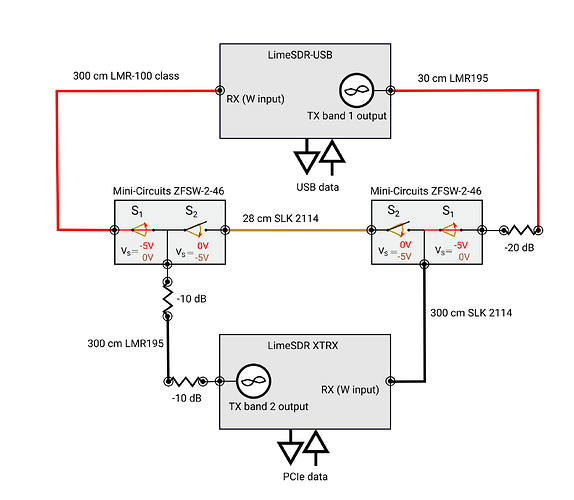Using cables and RF switches to interconnect the LimeSDR USB and XTRX Tx to Rx RF ports, and gnuradio selector blocks to select active base band paths (independent of RF path) I find that the USB device can be received by the XTRX and the XTRX be received by the USB. The signal gains set on both source and sink blocks of both devices are the same; received signal levels are essentially the same in both directions. However, the transmitted XTRX signal received by the XTRX when RF path is XTRX-Tx to XTRX-Rx (same flow graph) is 60 dB lower than received from the USB.
The right pane in the screen shot below was created by the XTRX-Tx to USB-Rx RF connection with d.c signal (left pane) applied to the sink block. The sinusoidal output is the result of a Tx-Rx frequency difference between XTRX and USB devices.
The right pane in the screen shot below was created by the USB-Tx to XTRX-Rx RF connection with d.c signal (left pane) applied to the sink block. A ramp waveform appears on top of the sinusoidal output resulting from the Tx-Rx frequency difference between XTRX and USB devices. I don’t understand where the ramp comes from; my guess is a correction being applied by the XTRX.
The right pane in the screen shot below was created by the XTRX-Tx to XTRX-Rx RF connection with cosine (left pane) applied to the sink block. The gain settings pf XTRX-Tx and XTRX-Rx are increased (60 dB combined) to see the output.
The right pane in the screen shot below was created by no RF connection between XTRX-Tx and XTRX-Rx and with a cosine (left pane) applied to the sink block. The level suggests an internal connection between Rx and Tx within XTRX that is approximately 1/4 the level of that coming through the RF ports.
The right pane in the screen shot below was created by the XTRX-Tx to XTRX-Rx RF connection with dc (left pane) applied to the sink block. The ramp and sinusoidal waveform is not present even with the increased gain of 60 dB.
Comparing configurations (using LimeGUI) between USB and XTRX, the only striking feature (beyond gain and band parameter settings) is that the USB has Rx Gain and Phase corrector bypasses (GC_BYP_RXTSP 0x40C[1], and PH_BYP_RXTSP) 0x40C[0]) set. The USB Tx DC, Gain and Phase corrector bypasses (DC_BYP_TXTSP 0x208[3], GC_BYP_TXTSP 0x208[1] and PH_BYP_TXTSP 0x208[0]) are also set.
Can someone out there enlighten me as to what may be going on?
The following may be not be related but the recently added DC&IQ calibration enable feature in both sink and source blocks does not work as expected in the flow graph used to generate the above images.
Calibrate DC & IQ enabled one block at a time yields one of the following three related console log output lines.
(1) USB sink, XTRX source: “LimeSuiteNG :error: lms7002m_set_frequency_sx: Rx LO(797999995 Hz) - cannot deliver frequency”
(2) USB source: “LimeSuiteNG :info: Rx calibration finished”
(3) XTRX sink: " "
LimeSuiteNG: commit 04e824… was used.






